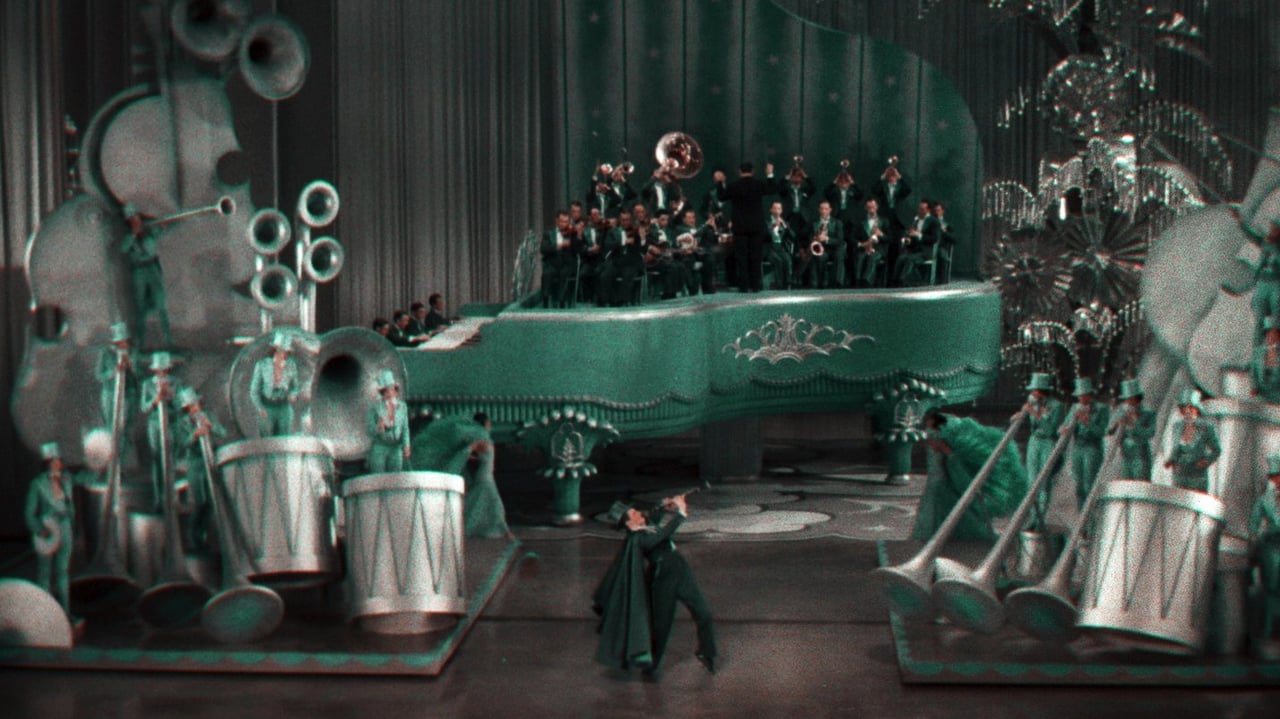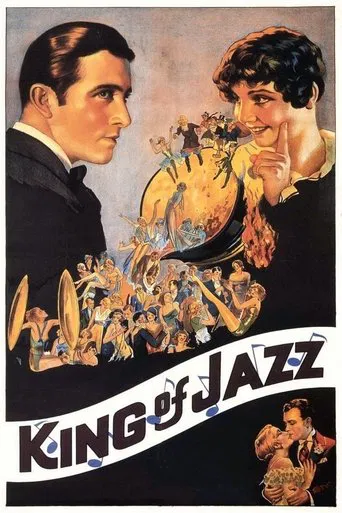

I just received the alleged restored version of king of jazz.Like the1983 v.h.s. version,the color wasn't restored to the way it looked on the Rohaur print and the way follow thru,vagabond king ,whoopee,before that was enhanced,Viennese night before was taken off you tube,and the fragment of Sally and on with the show and gold diggers of Broadway.This is the way king of jazz is suppose to look.The preservationist ,probably at the demand of universe gave it the same Multi color look,aka two color Cinecolor,look.Although some spot had three color blue tint or the whole scene was enhanced in 3 colors.Why? to sell it to the modern audience.A modern audience is suppose to see a classic film the way it was presented to theatrical audiences. limit palette,including magna color ,cine color and two color Technicolor. Even a film that might reflect the racism and antisemitism of the past ,to understand it.Unfortunately Herbert and Natalie Kalmus would welcome the change,since Technicolor was experimenting with 3 color cinema photography back in 1930 ,also.Those fragment look like it was shot in 1933 rather than 1930.The preservationist stripped the yellow orange tint out of the whole picture ,so it wouldn't look like an antique .It is and antique! except it.Before the opening of the king of jazz book the green on some of the spots were blue greened.The cartoons green sky ,was changed to blue green.Meet the boys was three colored ,except for the banjo player,the walls were tinted pure blue.The green part of the wall ,on the left,in Bridal vale was blue green from it's green look.Other than stripping the orange yellow tint in," meet the girls, wasn't touched.Ladies of the press was a cine colored as the VHS version,but,sharper.I met her in Monterrey all blue green tint convert.A kiss in the park blue green tint as usual,but all 35 m.m. print.Bing Crosby rhythm boy sequence ,blue green tint ,before lights turn on.Bluish green back ground behind Crosby's head.Spring time,subtle blue green.Happy feet ,left alone.A dash of spice -no change in color.Willy Hall, no change in the color.Song of the Dawn,introduction Cinecolor look ,the number,not touched.All noisy on the eastern- free from color and tint change.The sing along a bit three colored. I like to do things for you-hard to tell until near the end of the song Jeanie Lang 's dress tint stated to turn more green than earlier blue green,Raga muffin Romeo as cine colored as the VHS version. Oh forever more ,before the scene show up the darkness is pure blue,but when it lights up and the walls become deep light green tint.The fish store - hard to tell.The final- Cinecolor like old print ,but, sharper,the restored spots had some pure blue tint on the dark side,but Spanish dancer's faces is not washed out.The end of finale no blue tint.Rhapsody in blue introduction blue green tint graphics on wall.For d.v.d and Blu- ray version,rhapsody in blue dark green was lighted and some blue was added lightly blue green Roy Bargy green piano was changed to Cinecolor blue -green,contrary to the archive version that was in you tube.The recently discovered peep hole black out,color not touched.When I saw picture of the rohaur print, on the Vitaphone project news letter and Nitrate Ally news letter, I already knew that if it was restored that the color could be revision.I was right.No modern distributor these days like red and green history.They think if they can make a two color Technicolor features to look modern they can draw more audience or sale,not really.I tolerate the new color,but don't except it.On the bright side the Fish song is fully complete,without photo enhancement.The Ragamuffin Romeo is also compete.The finale has been completely restored.The singalong is complete ,but with photo enhancement The introductions have been put back on in photos enhancement.Leonard Maltin should of been ashamed not to express dissent against the revision of most of the two color.Good news the Cinecolor look out take ," We Have been lucky," Look whats it makes me and Horses neck is part of the out take menu and a cine color enhanced version of the reissue beginning title,so you can throw your VHS away and unofficial DVD version.It also contains a visual and audio partial version of the King of jazz book,for those who don't' have it.Micheal Feinstein discuses it.There are two Oswald rabbit Cartoons.I will explain it on a separate title.There are two shorts,"All American and I know everyone and everybody's Racket ,starring Walter Winchell.I too will discuss this on two separate titles on i.m.d.b. In spite of the color change,on many scenes it still worth watching and owning.A clear digital print.Complete numbers.a condense version of king of jazz book visual and audible.Cartoons.discussions.Good entertainment. 03/29/18
... View MoreFortunately, the history of jazz was little troubled by this farcical musical travesty. The one black person... (did you know that it was people of color who created Jazz, innovated and sustained it decade after decade only to be constantly supplanted by less talented and creative whites who popularized their music and made millions off it?)... who appears is a cute little girl sitting on the lap of Paul White-Man, the purported king of jazz in a brief segment. The only jazzy number in the film is 'Happy Shoes' with the entire remainder of the film devoted to middle of the road popular schmaltz music and pseudo-classical Gershwin. That said, the film, however distasteful, dated and unfunny, is in some ways an important historical predecessor of the Hollywood musicals to come.I had read that the production numbers were something to see, but by the end I no longer cared. Not so hot. Comedy, very poor. Female vocals, very poor. White-man and his vaudevillians, crap. Bing Crosby, as usual, quite good.
... View MorePaul Whiteman was a huge star in the 20s with his terrific jazz band. He might have been the original star band leader. In "The King of Jazz" he also shows himself to be a decent comic actor as well. He's best remembered for his recording of Gershwin's "Rhapsody in Blue," which is featured in this early revue film."King of Jazz" is solid entertainment with some lavish and grand-scale production numbers that boast Bing Crosby, John Boles, Laura LaPlante, the Brox Sisters, Jeanie Lang, and of course Whiteman's band.Best songs are "Happy Feet," "A Bench in the Park," "The Song of the Dawn," and a jazzy "Bluebirds and Blackbirds" number with Crosby as one of the Rhythm Boys (with Harry Barris and Al Rinker).Al Norman does an amazing dance number to "Happy Feet." Jeanette Loff is rather bland in the "bridal veil" number. The Sisters G in their Louise Brooks hairdos are OK in their dance numbers. And there's a lot of short comedy bits that feature Walter Brennan, Slim Summerville, Grace Hayes, Merna Kennedy, William Kent, and others.Although I still prefer "The Hollywood Revue of 1929" this revue is also excellent in its use of lavish production numbers, color, and special effects. For fans of early musicals this one is not to be missed.Whiteman, Crosby, and Boles are all great.
... View MoreThis film is in two-tone Technicolor. It is rather like a vaudeville brought onto the stage with music, short sketches, and variety turns. From the perspective of today, the glaring omission is that the American Negro influence is not given any acknowledgement whatever. In the melting pot scene at the end the American Negro influence is glaring conspicuous by its absence. Although there is certainly a European influence in American jazz music, it is less of an influence than African music or - don't forget - Mexican music. But the film was of its time, and at that time, the Amrican Negro playing jazz was not officially referred to, and it would be some time before black artists could be spoken of as musical heroes. Funnily enough Paul Whiteman's star singer Bing Crosby, who appears in this film with the Rhythmn Boys, would have a huge role to play here by his collaborations with black artists like the Mills Brothers. In spite of all this, we must regard this film in the context of the period it was made, regret the Negro omissions and enjoy the film for its own sake.Other impressive acts are the trick violinist playing "Pop Goes the Weasel", bel canto singer John Boles and that amazing rubber-legged dancer Al Norman. (Eat your heart out, John Travolta)Although I was not born till a quarter of a century after the release of this film, I cannot but help a feeling of nostalgia. We will certainly never see the like of these acts again. But for this film, the magic of Boles and Norman and the Whiteman orchestra would be gone for good.
... View More